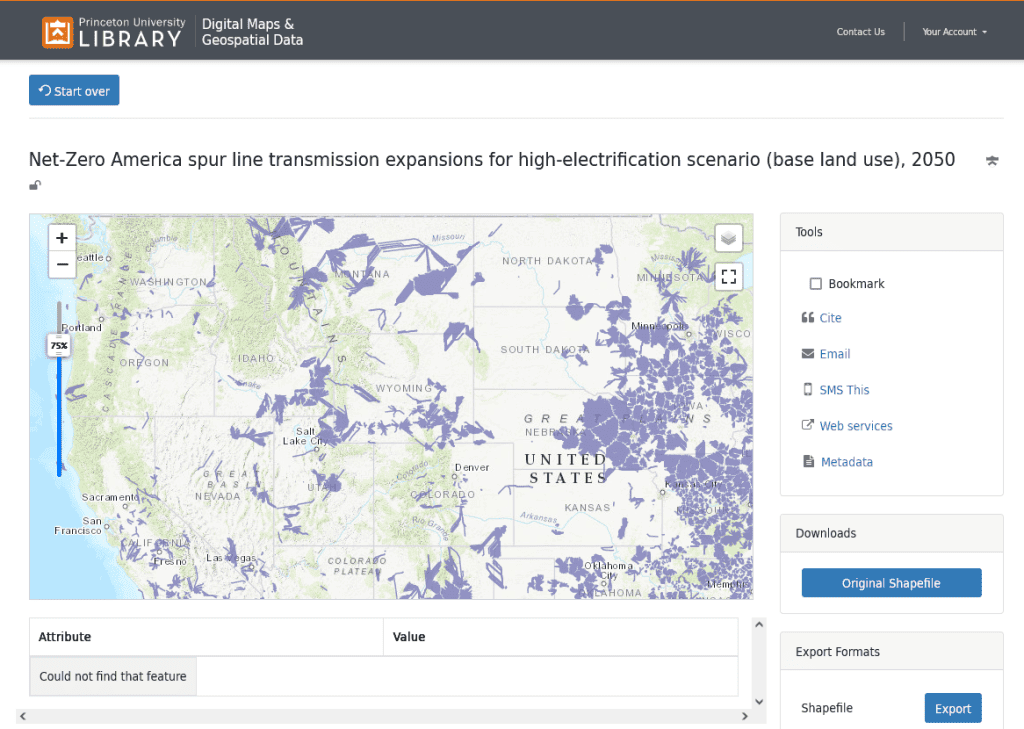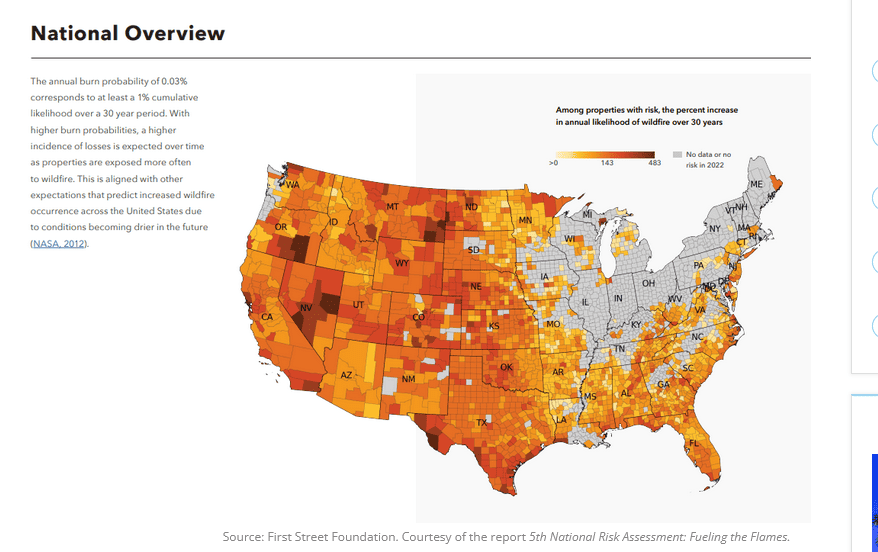
Increasing risk of wildfire in 2050 (not that I necessarily believe this, but) from First Street Foundation
Power Lines Start Fires
1. As we have seen in various wildfires, power lines can start fires. This particularly seems to happen under windy conditions, which makes for fires that are hard to control and in some cases, air resources can’t be used during these high wind events. Large transmission lines are not as susceptible, we would think. But how do people know when a major one is proposed in their neighborhood if it’s the “safe” kind or the “unsafe” kind?
Too Expensive to Protect, Need to Shut Off Instead
2. It’s a lot of work and money to maintain power lines, so much so that PG&E is thinking of changing their strategy to “just shut them down” instead, see this WSJ piece. Fires start, people sue, and ratepayers ultimately pay the bill, raising rates. Do we expect more bad fire weather conditions due to climate change? That would mean more times for electricity to be turned off. Who is likely to be able to afford back-up generators or batteries? If we’re cutting down on gas and there may be a shortage of battery minerals… This might be difficult as well.
Instead, the company will rely more heavily on new power-line settings in areas at high risk of fire. The lines shut off within a tenth of a second when branches or other objects touch them, reducing the risk of sparks.
Industry officials say customers may experience more power outages in coming years if the company’s scaled-back approach to tree trimming results in more branches hitting wires. The company said it would work to assess outage-prone circuits and address the issues with targeted tree clearing and other safeguards.
PG&E says the new approach will be both safer and less expensive as it works to permanently reduce wildfire risk by burying 10,000 miles of power lines in the coming years, an ambitious plan expected to cost at least $20 billion. The company is challenged in its ability to raise capital following a complex bankruptcy restructuring and has been working to cut costs in order to fund the work.
So people sued them, so they went bankrupt and have to do the best they can with the funding available. At least until the next cycle of wildlife/litigation/bankruptcy where one might expect them to have even less money.
From a Reuters story on the power grid:
“We shouldn’t have to worry about people dying because someone flips off the electric switch.”
3. The New York Times editorial board opined:
The United States needs 47,300 gigawatt-miles of new power lines by 2035, which would expand the current grid by 57 percent, the Energy Department reported in February. A 2021 report by the National Academies of Sciences, Engineering and Medicine arrived at a similar figure. To hit that target, the United States needs to double the pace of power line construction.
and what could go wrong with the well-intentioned “federal pre-emption of state and local authorities” which “would only apply to major projects of national importance..”
According to CNBC:
Building transmission lines is more important for distributing renewable energy than it is for using fossil fuels because with coal, natural gas or nuclear baseload energy, the source of energy can be moved to where it is needed.
“With renewables, you can’t do that,” Robb said. “You’ve got to generate power where the sun is shining and where the wind is blowing.” Insufficient transmission lines have become a major “bottleneck” in deploying renewable resources, Robb told CNBC.
Does anyone think (no, I don’t think nuclear is a fossil fuel) maybe nuclear has some practical advantages- if we didn’t have to build new power lines (which we’re not probably going to actually build), plus wouldn’t it be safer and more secure than running new transmission lines across the country? Plus, I will predict that we’re actually not going to expand the grid by 57% by 2035; people, supply chains, funding and practicalities of all shapes and sizes, including pushback by those affected. There’s a vaguely colonialist undertone as well.. like negatives accruing to some states and cheaper energy to others.. as in this Reuters story:
A swathe of grid expansions are needed in Central U.S. to pursue national renewable energy goals and lower power prices in neighboring regions, the Department of Energy said in a draft transmission study.
This kind of “some win some lose” does not go unnoticed by affected communities.
In this Reuters story, apparently we have enough problems with the power lines we have, that need to be fixed.
As the weather gets wilder, the grid gets older. The U.S. Department of Energy found that 70% of U.S. transmission lines are more than 25 years old in its last network-infrastructure review in 2015. Lines typically have a 50 year lifespan. The average age of large power transformers, which handle 90% of U.S. electricity flow, is more than 40 years. Transformer malfunctions tend to escalate at about 40 years, according to research by reinsurance provider Swiss Re.
***
Next post:
Some Impacts of Transmission Lines and Audubon’s Point of View

Another BIG collision between climate change mitigation and climate change adaptation is fuel reduction logging, and the land management agencies still have a serious blind spot about it. The agencies’ NEPA analyses still frequently claim that logging to control fire and fuel has climate benefits when the math shows just the opposite. This issue is not going away. In fact, it will get much worse as the agencies ramp up the “wildfire crisis” machine.
If you ignore the climate benefits of good silviculture, you’re not seeing the big picture. Plain and simple.